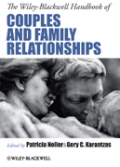
The Wiley-Blackwell handbook of couples and family relationships
Noller, Patricia
Karantzas, Gery C.
The Wiley-Blackwell Handbook of Couples and Family Relationships presents original articles from leading experts that link research, policy, and practice together to reflect the most current knowledge of contemporary relationships.Offers interesting new perspectives on a range of relationship issues facing twenty-first century Western society Helps those who work with couples and families facing with relationship issues Includes practical suggestions for dealing with relationship problems Explores diverse issues, including family structure versus functioning; attachment theory; divorce and family breakdown; communication and conflict; self regulation, partner regulation, and behavior change; care-giving and parenting; relationship education; and therapy and policy implications INDICE: Introduction. Section 1: Trends in Couple and Family Relationships. 1. From Form to Function: Contemporary Choices, Changes and Challenges (RuthWeston, Australian Institute of Family Studies; Lixia Qu, Australian Institute of Family Studies; Alan Hayes, Australian Institute of Family Studies). 2. Social Trends and their Impact on Couple and Family Relationships (David de Vaus, The University of Queensland). 3. Changing American Families in the 21st Century (Suzanne M. Bianchi, University of California; Sara B. Raley, McDaniel College; Lynne M. Casper, University of Southern California). Section 2: Families across the Lifespan. 4. The Role of the Family across the Life Span (Toni C. Antonucci, Institute for Social Research; Kristin M Wong, University of Michigan; Sarah Trinh, University of Michigan). 5. Parents and Adolescents: Challenges and Misconceptions (Ross Wilkinson, Australian National University). 6. Family Caregiving: Perspectives of Adult Children and Older Parents (Gery C. Karantzas, Deakin University). 7. Late Life Transitions and Interventions: Impacts on Marriage, Remarriage, and Widowhood (Kathleen Piercy, Utah State University) Section 3: Communication and conflict processes in couples and families. 8. Conflict Avoidance in Families: Functions, Outcomes, and Applied Implications (John P. Caughlin, University of Illinois at Urbana-Champaign; Jennifer L. Hardesty, University of Illinois at Urbana-Champaign; Ashley V. Middleton, University of Illinois at Urbana-Champaign) 9. Conflict in Family Relationships (Patricia Noller, University of Queensland) 10. Demand-Withdraw Communication in Couples: Recent Developments and Future Directions (Kathleen A. Eldridge, Pepperdine University and Brian Baucom, University of Southern California). Section 4: Individual Differences Perspectives on Intimacy, Love and Caregiving. 11. Adult Attachment and Sexuality: Attachment Insecurities Bias the Functioning of the Sexual Behavior System (Phillip R. Shaver, University of California, Davis and Mario Mikulincer, New School of Psychology). 12. Sexual Dysfunction in Intimate Heterosexual Relationships (Denisa Goldhammer, Deakin University and Marita P. McCabe). 13. Regulating Incentives and Threats in Close Relationships: Approach and Avoidance Motivation (Shelley L. Gable, University of California, Santa Barbara). 14. Attachment and Caregiving: Functions, Interactions,and Implications (Melanie Canterberry, University of Kansas; Omri Gillath, University of Kansas; Gery C. Karantzas, Deakin University). Section 5: Cognitive and Affective Processes in Couple Relationships. 15. Attachment Insecuritiesand Relationship Self-Regulation: An Investigation of the Meditational Role of Attributions for Negative Partner Behavior (Zoë J. Hazelwood, Queensland University of Technology). 16. The Costs and Benefits of Trying to Change Intimate Partners (Nickola C. Overall, University of Auckland). 17. Through the Eyes of
- ISBN: 978-1-4443-3450-0
- Editorial: Wiley-Blackwell
- Encuadernacion: Cartoné
- Páginas: 520
- Fecha Publicación: 20/01/2012
- Nº Volúmenes: 1
- Idioma: Inglés
